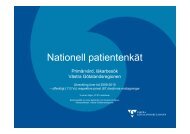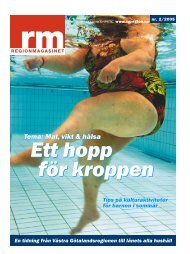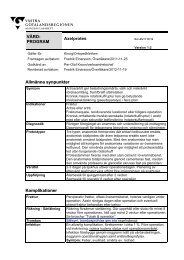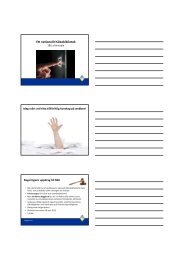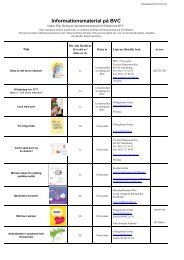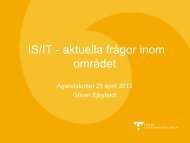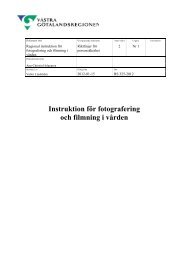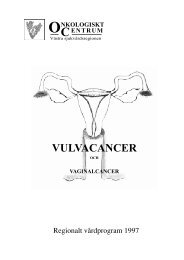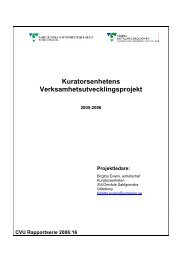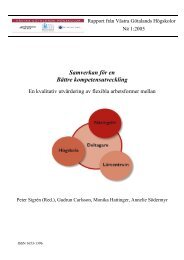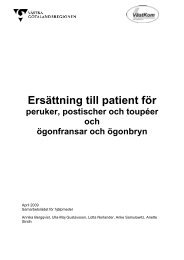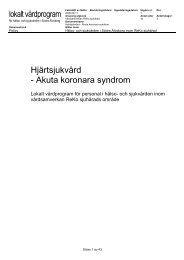FOURTEENTH ANNUAL EUROPEAN PRESSURE ULCER ...
FOURTEENTH ANNUAL EUROPEAN PRESSURE ULCER ...
FOURTEENTH ANNUAL EUROPEAN PRESSURE ULCER ...
You also want an ePaper? Increase the reach of your titles
YUMPU automatically turns print PDFs into web optimized ePapers that Google loves.
Thursday September 1st<br />
Proceedings of the 14th Annual European Pressure Ulcer Meeting<br />
Oporto, Portugal<br />
EPUAP Annual Conference 2011 Oporto Portugal<br />
Moisture Related Skin Excoriation: a retrospective review of assessment and management<br />
across 5 Glasgow hospitals<br />
Bianchi J 1* , Johnstone A 2<br />
1* Independent Medical Education Specialist, Scotland, Janice.bianchi@gmail.com<br />
2 NHS Greater Glasgow and Clyde, Scotland<br />
Introduction<br />
Skin excoriation is an extremely debititating and often<br />
very painful condition. It can also lead to the<br />
development of moisture lesions and/or pressure<br />
ulcers. In recognition of this, a skin excoriation<br />
grading tool was developed by members of the<br />
National Association of Tissue Viability Nurses<br />
Scotland in conjunction with Quality Improvement<br />
Scotland. The tool was introduced across NHS<br />
Greater Glasgow and Clyde (NHS GGC) between<br />
January and June 2009. This was followed by the<br />
introduction of clinical guidelines and a protocol on the<br />
use of for Faecal Management Systems (FMS)<br />
recognising that faecal incontinence can cause<br />
extreme irritation and skin injury to the perianal area<br />
due to bacteria and digestive enzymes within faecal<br />
matter (Johnstone 2005). In order to determine<br />
whether the excoriation tool and FMS guidelines were<br />
being implemented, a retrospective review of case<br />
notes was carried out across 5 NHS GGC hospitals.<br />
The main aim of the study was to answer the<br />
questions:<br />
1 Was there evidence that the excoriation tool was<br />
being used?<br />
2 Was a consistent approach in the management of<br />
patients with excoriation including the use of FMS?<br />
Methods<br />
One year after implementation, a retrospective review<br />
of the case notes of patients who had been referred to<br />
tissue viability services with skin excoriation was<br />
carried out. For the purposes of this study, data were<br />
collected on demographics, length of stay, treatment<br />
options and concordance with guidelines/excoriation<br />
tool.<br />
Results<br />
A total of 35 sets of case notes were reviewed. Of<br />
these 25 patients fitted the criteria for the study, the<br />
remaining 10 patients had chronic wounds but no<br />
evidence of skin excoriation.<br />
Table 1 details demographic details, it is noteworthy<br />
that that many patients had a prolonged length of stay,<br />
this was due to deteriorating medical condition in many<br />
but skin damage could not be excluded as a<br />
contributory factor.<br />
Table 1: Summary of demographic data and length of stay<br />
Age Sex LOS<br />
Range 39-89<br />
Mean 63.4<br />
F 16(64%)<br />
M 9 (36%)<br />
10-180 days<br />
Mean 40.8 days<br />
73<br />
Table 2 details the many different products being used<br />
to treat excoriation, some of which are outwith the<br />
recommendations of the excoriation tool.<br />
Table 2: Treatments recommended in excoriation tool vs<br />
treatments used<br />
Recommended: barrier cream, barrier film<br />
Used: Cavilon (cream, lollipop, spray); flamazine; canesten HC;<br />
hydrogel; aqueous cream; clotrimazole; fucidin, zinc and caster oil;<br />
doublebase; purilon; conotrane; 50:50 white soft paraffin in liquid<br />
paraffin; E45<br />
The excoriation tool uses a 1-3 grading system, there<br />
was no evidence of this system being used. The<br />
preferred option was the use of various adjectives<br />
such as: red; excoriated; erythema; raw; fragile;<br />
tender.<br />
All 25 patients were either admitted with or developed<br />
acute faecal incontinence prior to the onset of<br />
excoriation. NHS GGC Guidelines suggest FMS<br />
should be considered when this occurs. Casenote<br />
review indicated FMS were considered in 9 (36%)<br />
patients and used in 5 (20%).<br />
Discussion<br />
From the evidence presented here, there is little<br />
evidence that the excoriation tool had been used to<br />
inform decision making.<br />
Additionally the clinical guidelines on FMS do not<br />
appear to have been fully implemented with only a<br />
small percentage of patients assessed for the device.<br />
Clinical relevance<br />
The onset of acute diarrhoea can cause skin injury<br />
within a short period of time. It is therefore essential<br />
that systems are put in place to minimize tissue<br />
damage. This study indicates that despite the fact that<br />
guidance was available, uptake was poor, therefore<br />
we need to develop better methods of disseminating<br />
information. A treatment pathway with consideration<br />
for circulation may be the next step.<br />
Acknowledgements<br />
We appreciate the help of NHS GGC medical records<br />
Conflict of Interest<br />
This study was supported by an unrestricted<br />
educational grant by ConvaTec<br />
References<br />
[1] Johnstone A Wounds UK. 1;3:110-114, 2005<br />
Copyright © 2011 by EPUAP



